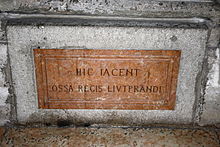The formation of the Church-State by wars and pillage
‘But be vigilant, my children, strive earnestly to take part in what we desire! For you know that he who is on the other side will be excluded from eternal life’. —Pope Stephen II
‘The struggle for Christ and the Church is assigned to the Franks as their historic vocation’—John Haller

Plaque marking the casket containing Liutprand’s
bones in San Pietro in Ciel d’Oro in Pavia.
Papal negotiations between Byzantium, Longobards and Franks
While the dispute over the images was raging in Byzantium and its repercussions were shaking Byzantine Italy, King Liutprand was trying to seize the opportunity to extend the Longobard kingdom throughout Italy, especially in Emilia and Romagna. He systematically annexed Byzantine territory, conquered castle after castle, and strengthened his authority over the duchies of Spoleto and Benevento. In short, he continually increased his political power within and beyond his borders. And when in 732 (or 733) Liutprand first conquered Ravenna—which had been in Byzantine hands for almost two hundred years and the exarch fled to the Venetian lagoons—the ally proved too dangerous for the Papacy…
Liutprand was a pious person, a faithful Catholic, a friend of the priests and an outspoken promoter of the Church. He erected a domestic chapel in his palace and was the first Longobard king to procure private chaplains. He instituted ecclesiastics ‘to celebrate daily divine service for him’ (Paul the Deacon). One of his relatives was the bishop of Pavia. He was generous with the clergy. He founded monasteries, built many churches which he decorated and practised the superstitious cult of relics. A prologue to his laws opens with a biblical quotation. And in a later prologue he expressly presents himself as a defender of the Roman Catholic faith. Gregory II fought against the return of the nuns to civil life, and Liutprand supported him with a relevant law…
______ 卐 ______
Editor’s note: Contrary to what we were told as children, Christianity was imposed on whites through royal power. This vindicates what I said yesterday: that only a brutal iconoclasm ordered by a Fourth Reich could cure the white man from the mental virus that is Christianity.
______ 卐 ______
Transamundus II had forcibly deposed his father Farvald in 724, imposing on him the tonsure and entry into the clerical state. When Liutprand advanced against him (738-739), set fire to the Pentapolis and ravaged Spoleto, Transamundus took refuge with the pope, who put the Roman army at his disposal against Liutprand. Liutprand in turn stormed into the Roman duchy, sacking it and conquering its castles on the northern frontier. And war broke out everywhere, both in Roman territory and in the lands of Ravenna. It is true that Transamundus provisionally (in December 740) conquered its capital and killed the new duke Hilderic, instituted by Liutprand. But the pope, who also used his bishops in the Longobard kingdom against his sovereign, was wary of the king’s power and appealed to the Frankish prince Charles Martell, who was far away but strong.
The Frankish steward, who from 720 undisputedly controlled the whole kingdom and fought almost without pause—also involving the Church to a large extent and using the monasteries as bridgeheads (Schwarzach, Gengenbach, Schuttem, the abbey of Reichenau)—saw the expansion of his authority and the spread of Christianity as inextricably linked. To put it briefly, Charles had become the most powerful man in Europe, and so accustomed was he to war and conquest that, as contemporary sources expressly note, there was hardly a year without war (namely 740). And that man appeared precisely as the true patron and protector of Christ’s representative.
So Gregory III tried repeatedly in 739 and 740 to incite Charles Martell against Liutprand, although the two were personal friends. The pope dreamed of unshackling Rome from the Byzantine empire and offered Charles the collation of the Roman consulship as well as the rank of patrician. Gregory III, who persisted in his efforts until his death (‘In no age’, a Frankish chronicler comments flatteringly, ‘was such a thing ever heard of or seen’) appealed in vain to Charles. The latter, who was little devoted to the Church, who was genealogically related to the Longobards, who was allied with and a friend of Liutprand, who in 737 adopted his son Pipin, remained completely deaf to the first call for papal help and died before a second could eventually reach him.
Among the ancestors of the Carolingians, Charles is the only one whom later ecclesiastical authors condemn, casting him into hell for all eternity because of the systematic reduction of the ecclesiastical patrimony due to him (precaria verba regis). In his lifetime this was interpreted in a completely different way, even if he had one of his ecclesiastical relatives beheaded, Abbot Wido, who, according to the monastic chronicle, was more fond of hunting and war than of divine service. Of course, he didn’t have him beheaded for that, but a conspiracy against Charles. What we know for sure is that he was far from being a stubborn enemy of the Church. We know of eight donations of goods, which he made to him personally.